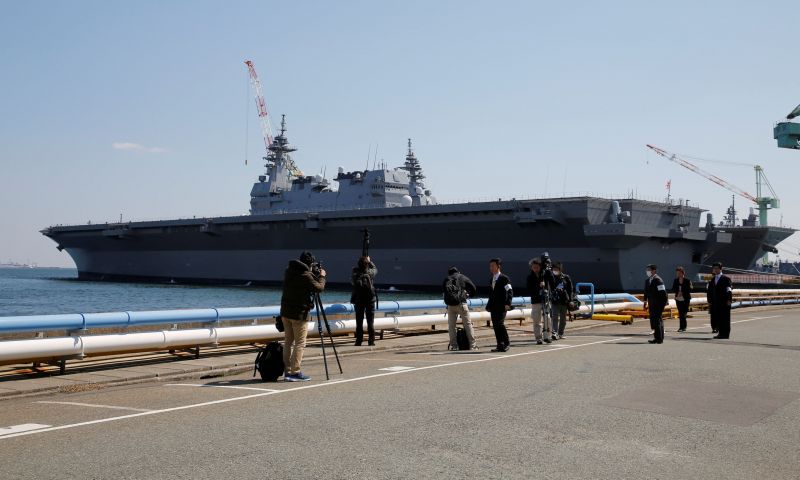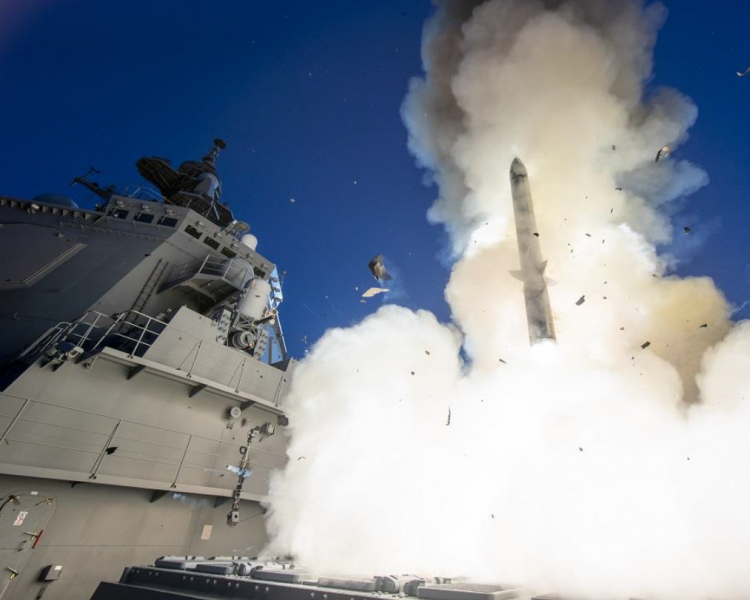-
![[image]](https://www.balancer.ru/cache/forums/attaches/2021/02/128x128-crop/21-9497993-g098243e2ei.jpg)
Современные ВМС Японии
Морские силы самообороны Японии (современность)Теги:
Вованыч> Минзаг (хотя официально он "minesweeper tender") "Бунго", июнь 2022 г.
Анфас он более симпатичен
Анфас он более симпатичен
Прикреплённые файлы:


JS YAMAGIRI и JS ONAMI провели двусторонние учения с USS RONALD REAGAN, 13-24 августа 2022 года.
Прикреплённые файлы:


Вертолетоносец класса "Хьюга" JS Hyuga (DDH-181) прибывает в Йокосуку, Япония - 5 сентября 2022 года.
Прикреплённые файлы:


JS Noshiro (FFM-3) возвращается в порт после ходовых испытаний.
Прикреплённые файлы:


Союзники.
Прикреплённые файлы:


Может быть? Или?
Может быть, что первая партия из 8 кораблей будет ориентирована на ASW + ASuW, в то время как более поздние модели могут быть вариантом AAW.
Запланировано всего 22 корабля, чтобы заменить 8 кораблей классов Асагири и 6 кораблей классов Абукума.
Может быть, что первая партия из 8 кораблей будет ориентирована на ASW + ASuW, в то время как более поздние модели могут быть вариантом AAW.
Запланировано всего 22 корабля, чтобы заменить 8 кораблей классов Асагири и 6 кораблей классов Абукума.
Прикреплённые файлы:


Jul 12, 2022. Процесс идет... 

Прикреплённые файлы:


Япония, Канада и Соединенные Штаты завершили на этой неделе учения Noble Raven 22, которые проходили в водах от Гуама до Южно-Китайского моря, согласно пресс-релизу Морских сил самообороны Японии.
Учения, включавшие тактическую подготовку, начались 30 августа и включали вертолетоносец JMSDF JS Izumo (DDH-183) и эсминец JS Takanami (DD-110), фрегат Королевских ВМС Канады HMCS Vancouver (FFH331), эсминец ВМС США USS Higgins (DDG-76) и корабли пополнения USNS. Джон Эрикссон (T-AO-194) и USNS Раппаханнок (T-AO-204).
“Идзумо" и "Таканами" образуют первое надводное подразделение в рамках Индо-Тихоокеанского развертывания JMSDF в 2022 году (IPD22), четырехмесячного развертывания по всему Индо-Тихоокеанскому региону с 13 июня по 28 октября. "Благодаря активизации практических учений мы улучшили тактические возможности и взаимодействие между JMSDF, ВМС США. и Королевским военно-морским флотом Канады, и мы способствовали сотрудничеству японско-американо-канадских военно-морских сил с целью создания Свободного и открытого Индо-Тихоокеанского региона”, - сказал контр-адмирал. Тосиюки Хирата, командир первого наземного подразделения,
HMCS "Ванкувер" вместе с родственным кораблем HMCS "Виннипег" (FFH338) находятся на передислокации в регион после их участия в учениях "Обод Тихого океана 2022", которые завершились в августе. 4. HMCS Winnipeg в настоящее время проводит операцию "Проекция", в рамках которой канадские Вооруженные силы проводят посещения портов, обучение, учения и взаимодействия с иностранными военно-морскими силами и другими международными партнерами по безопасности в регионе. HMCS Winnipeg в настоящее время находится в Сингапуре, пришвартовавшись там во вторник для недельного захода в порт и технического обслуживания.
HMCS Vancouver проводит как операцию "Проекция", так и операцию "Неон" – вклад Канады в скоординированные многонациональные усилия по поддержке санкций Совета Безопасности Организации Объединенных Наций, введенных в отношении Северной Кореи. Участие Канады включает в себя наблюдение за любыми судами, нарушающими санкции ООН.
Учения, включавшие тактическую подготовку, начались 30 августа и включали вертолетоносец JMSDF JS Izumo (DDH-183) и эсминец JS Takanami (DD-110), фрегат Королевских ВМС Канады HMCS Vancouver (FFH331), эсминец ВМС США USS Higgins (DDG-76) и корабли пополнения USNS. Джон Эрикссон (T-AO-194) и USNS Раппаханнок (T-AO-204).
“Идзумо" и "Таканами" образуют первое надводное подразделение в рамках Индо-Тихоокеанского развертывания JMSDF в 2022 году (IPD22), четырехмесячного развертывания по всему Индо-Тихоокеанскому региону с 13 июня по 28 октября. "Благодаря активизации практических учений мы улучшили тактические возможности и взаимодействие между JMSDF, ВМС США. и Королевским военно-морским флотом Канады, и мы способствовали сотрудничеству японско-американо-канадских военно-морских сил с целью создания Свободного и открытого Индо-Тихоокеанского региона”, - сказал контр-адмирал. Тосиюки Хирата, командир первого наземного подразделения,
HMCS "Ванкувер" вместе с родственным кораблем HMCS "Виннипег" (FFH338) находятся на передислокации в регион после их участия в учениях "Обод Тихого океана 2022", которые завершились в августе. 4. HMCS Winnipeg в настоящее время проводит операцию "Проекция", в рамках которой канадские Вооруженные силы проводят посещения портов, обучение, учения и взаимодействия с иностранными военно-морскими силами и другими международными партнерами по безопасности в регионе. HMCS Winnipeg в настоящее время находится в Сингапуре, пришвартовавшись там во вторник для недельного захода в порт и технического обслуживания.
HMCS Vancouver проводит как операцию "Проекция", так и операцию "Неон" – вклад Канады в скоординированные многонациональные усилия по поддержке санкций Совета Безопасности Организации Объединенных Наций, введенных в отношении Северной Кореи. Участие Канады включает в себя наблюдение за любыми судами, нарушающими санкции ООН.
Прикреплённые файлы:


JS "Изумо" (DDH-183) и подводная лодка класса "Сорю" в Южно-Китайском море.
Прикреплённые файлы:


sam7:
предупреждение (+2) по категории «Троллинг, злостная провокация флейма или особенно агрессивное вызывающее поведение [п.11.1]»
- sam7 [05.10.2022 19:18]: Предупреждение пользователю: Zorro#03.10.22 08:35
JMSDF destroyers JS Chokai (DDG-176) and JS Ashigara (DDG-178) - only one in photo; and 대한민국 해군 Republic Of Korea Navy destroyer ROKS Sejong the Great (DDG-991).
Прикреплённые файлы:


JS Haguro, DDG 180.
Прикреплённые файлы:


Japan is set to be the first country after the United States to field the Standard Missile SM-6 as part of a proposed $450 million arms package, according to a State Department notification to Congress.
Japan was conditionally approved to buy up to 32 of the Raytheon-built Standard SM-6 Block Is, pending congressional approval.
“The proposed sale will improve Japan’s Air Defense and Ballistic Missile Defense capabilities against potential adversaries in the region. It will also provide the U.S.-Japan Security Alliance with the latest and most advanced capabilities, reducing Japan’s reliance on U.S. Forces for the defense of Japan and further improving U.S.-Japan military interoperability. Japan will have no difficulty absorbing these missiles into its armed forces,” reads the notification.
The notification follows a 2017 decision from the Pentagon that conditionally approved Japan, South Korea and Australia to buy the missiles.
All three countries field guided-missile warships that are outfitted with Baseline 9 of the Aegis Combat System. Baseline 9 allows the ships to input targeting information into the SM-6 from another ship or aircraft in addition to a ship’s own sensors.
Australia’s three "Hobart"-class guided-missile destroyers, Japan’s two "Atago"-class and two "Maya"-class destroyers and three planned South Korean "Sejong the Great"-class destroyers feature Baseline 9.0.
The SM-6 features three different modes – anti-air warfare, anti-surface and a limited ballistic missile defense capability – but not all the features may be available to all three countries.
In particular, the Navy and the Missile Defense Agency have done several tests to prove the missile’s effectiveness against ballistic missiles in the terminal phase.
Last year, the MDA’s program executive officer for Aegis ballistic missile defense at the time, Rear Adm. Tom Druggan, called the SM-6 “our leading defense capability for hypersonic missile defense.”
Japanese destroyers also field the SM-3 designed for ballistic missile defense. Earlier this year, Japan indicated it would build two 20,000-ton warships designed specifically for ballistic missile defense missions.
Japan was conditionally approved to buy up to 32 of the Raytheon-built Standard SM-6 Block Is, pending congressional approval.
“The proposed sale will improve Japan’s Air Defense and Ballistic Missile Defense capabilities against potential adversaries in the region. It will also provide the U.S.-Japan Security Alliance with the latest and most advanced capabilities, reducing Japan’s reliance on U.S. Forces for the defense of Japan and further improving U.S.-Japan military interoperability. Japan will have no difficulty absorbing these missiles into its armed forces,” reads the notification.
The notification follows a 2017 decision from the Pentagon that conditionally approved Japan, South Korea and Australia to buy the missiles.
All three countries field guided-missile warships that are outfitted with Baseline 9 of the Aegis Combat System. Baseline 9 allows the ships to input targeting information into the SM-6 from another ship or aircraft in addition to a ship’s own sensors.
Australia’s three "Hobart"-class guided-missile destroyers, Japan’s two "Atago"-class and two "Maya"-class destroyers and three planned South Korean "Sejong the Great"-class destroyers feature Baseline 9.0.
The SM-6 features three different modes – anti-air warfare, anti-surface and a limited ballistic missile defense capability – but not all the features may be available to all three countries.
In particular, the Navy and the Missile Defense Agency have done several tests to prove the missile’s effectiveness against ballistic missiles in the terminal phase.
Last year, the MDA’s program executive officer for Aegis ballistic missile defense at the time, Rear Adm. Tom Druggan, called the SM-6 “our leading defense capability for hypersonic missile defense.”
Japanese destroyers also field the SM-3 designed for ballistic missile defense. Earlier this year, Japan indicated it would build two 20,000-ton warships designed specifically for ballistic missile defense missions.
Прикреплённые файлы:


Эсминцы Kurama и Hyuga в заливе Сагами, 14 октября 2012 года
Автор: Yuriko Nakao
Japanese Maritime Self-Defense Force (MSDF) destroyer Kurama (R) leads destroyer Hyuga as a Japanese naval flag flutters during a naval fleet review at Sagami Bay, off Yokosuka, south of Tokyo October 14, 2012. REUTERS/Yuriko Nakao
Автор: Yuriko Nakao
Japanese Maritime Self-Defense Force (MSDF) destroyer Kurama (R) leads destroyer Hyuga as a Japanese naval flag flutters during a naval fleet review at Sagami Bay, off Yokosuka, south of Tokyo October 14, 2012. REUTERS/Yuriko Nakao
Прикреплённые файлы:


Мутант-эсминец Izumo ведет колонну на учениях в заливе Сагами, 6 ноября 2022 года
Автора нет - агентство Kyodo
An aerial view shows Japan's Maritime Self-Defense Force (JMSDF)'s multi-purpose destroyer Izumo (DDH-183) leading the fleet during the International Fleet Review to commemorate the 70th anniversary of the foundation of the JMSDF, at Sagami Bay, off Yokosuka, south of Tokyo, Japan November 6, 2022, in this photo taken by Kyodo.
Эсминец Takanami на учениях в заливе Сагами, 6 ноября 2022 года
Автор: Issei Kato
Japan's Maritime Self-Defense Force (JMSDF) destroyer Takanami leads the JMSDF fleet during the International Fleet Review to commemorate the 70th anniversary of the foundation of the JMSDF, at Sagami Bay, off Yokosuka, south of Tokyo, Japan November 6, 2022. REUTERS/Issei Kato/Pool
Автора нет - агентство Kyodo
An aerial view shows Japan's Maritime Self-Defense Force (JMSDF)'s multi-purpose destroyer Izumo (DDH-183) leading the fleet during the International Fleet Review to commemorate the 70th anniversary of the foundation of the JMSDF, at Sagami Bay, off Yokosuka, south of Tokyo, Japan November 6, 2022, in this photo taken by Kyodo.
Эсминец Takanami на учениях в заливе Сагами, 6 ноября 2022 года
Автор: Issei Kato
Japan's Maritime Self-Defense Force (JMSDF) destroyer Takanami leads the JMSDF fleet during the International Fleet Review to commemorate the 70th anniversary of the foundation of the JMSDF, at Sagami Bay, off Yokosuka, south of Tokyo, Japan November 6, 2022. REUTERS/Issei Kato/Pool
Прикреплённые файлы:


Вертолётоносец DDH-184 Kaga в Йокогаме, 22 марта 2017 года
Автор: Toru Hanai
22 March, 2017
Japan Maritime Self-Defense Force's (JMSDF) latest Izumo-class helicopter carrier DDH-184 Kaga is seen after a handover ceremony for the JMSDF by Japan Marine United Corporation in Yokohama, Japan, March 22, 2017. REUTERS/Toru Hanai
Автор: Toru Hanai
22 March, 2017
Japan Maritime Self-Defense Force's (JMSDF) latest Izumo-class helicopter carrier DDH-184 Kaga is seen after a handover ceremony for the JMSDF by Japan Marine United Corporation in Yokohama, Japan, March 22, 2017. REUTERS/Toru Hanai
Прикреплённые файлы:


Небольшой перекур от "черчения" приключился - в виде "брошюрки" по состоянию на конец 2022 г. Сильно за ТТХ не ручаюсь, взято из Вики.
Прикреплённые файлы:
Япония ПЛ и ПА-2022.docx (скачать)
[2,5 МБ]


Целая толпа водоплавающих на выгуле
【配信では絶対見れない】最新鋭潜水艦・護衛艦が連続出港!【横浜港】
2022年11月、海上自衛隊国際観艦式2022に伴い横浜港へ寄港、一般公開していた潜水艦、護衛艦等が横浜を出港しました。観艦式初参加の最新鋭艦と横浜の街並みをお楽しみください。 0:23 たいげい型潜水艦たいげい JS TAIGEI (SS-513) 2:13 もがみ型護衛艦もがみ JS MOGAMI(FFM-1) 02:56 あさひ型護衛艦しらぬい JS SHIRANUI (DD-120) 03:18もがみ型護衛艦くまの JS KUMANO(FFM-2) 04:57 あたご型護衛艦あたご JS ATAGO (DDG-177) 他の艦艇も順次アップ予定ですのでチャンネル登録をしてお待ちください。観艦式の思い出があればコメントで教えてください。 #フリートウィーク #国際観艦式 @uepshipsvideo
1. ДПЛ TAIGEI (SS-513)
2. новый фрегат MOGAMI(FFM-1)
3. ЭМ SHIRANUI (DD-120)
4. еще один фрегат, вошел в строй 22 марта сего года - KUMANO(FFM-2)
5. ЭМ ATAGO (DDG-177)
【配信では絶対見れない】最新鋭潜水艦・護衛艦が連続出港!【横浜港】
2022年11月、海上自衛隊国際観艦式2022に伴い横浜港へ寄港、一般公開していた潜水艦、護衛艦等が横浜を出港しました。観艦式初参加の最新鋭艦と横浜の街並みをお楽しみください。 0:23 たいげい型潜水艦たいげい JS TAIGEI (SS-513) 2:13 もがみ型護衛艦もがみ JS MOGAMI(FFM-1) 02:56 あさひ型護衛艦しらぬい JS SHIRANUI (DD-120) 03:18もがみ型護衛艦くまの JS KUMANO(FFM-2) 04:57 あたご型護衛艦あたご JS ATAGO (DDG-177) 他の艦艇も順次アップ予定ですのでチャンネル登録をしてお待ちください。観艦式の思い出があればコメントで教えてください。 #フリートウィーク #国際観艦式 @uepshipsvideo
1. ДПЛ TAIGEI (SS-513)
2. новый фрегат MOGAMI(FFM-1)
3. ЭМ SHIRANUI (DD-120)
4. еще один фрегат, вошел в строй 22 марта сего года - KUMANO(FFM-2)
5. ЭМ ATAGO (DDG-177)


Two Japanese Destroyers Score in Ballistic Missile Defense Test off Hawaii
Two Japanese Maya-class destroyers successfully test-fired SM-3 interceptors against ballistic missile targets off Hawaii last week, the Japan Maritime Self-Defense Force (JMSDF) announced on Monday.
The tests at the Pacific Missile Range on Kauai Island, Hawaii, validated the ballistic missile defense capabilities of Japan’s newest destroyers JS Maya (DDG-179) and JS Haguro (DDG-180) in cooperation with the U.S. Navy and U.S. Missile Defense Agency.
On Wednesday, JS Maya fired an Standard SM-3 Block IIA missile, successfully intercepting the target outside the atmosphere in the first launch of the missile from a Japanese ship. The SM-3 Block IIA has two distinct new features: larger rocket motors that will allow the missile to defend broader areas from ballistic missile threats and a larger kinetic warhead.
Haguro fired an Standard SM-3 Block IB missile with a successful hit outside the atmosphere. This was the first time the two ships conducted SM-3 firings in the same time period. In a Sunday test, the two ships worked together to share tracking data in a simulated ballistic missile shootdown.
“The success of this joint test marks a critical milestone in demonstrating, for the first time, a live fire of an Standard SM-3 Block IIA from a Japanese ship,” said MDA Director Vice Adm. Jon Hill in a Monday statement. “The cooperative development of the Standard SM-3 Block IIA by the Japanese government, U.S. government and industry team, and the integration with the Aegis Weapon System on Japan’s Ballistic Missile Defense-capable ships, is a remarkable achievement and vitally important in defending against an ever-increasing threat. I congratulate the Japan Maritime Self Defense Force, U.S. Navy, MDA team, and our industry partners on this accomplishment.”
JS Maya and JS Haguro are Japan’s newest destroyers, commissioned in 2020 and 2021 respectively, and, along with the two Atago-class and four Kongo-class destroyers, are equipped with the Aegis Combat System. Japan is planning to build two Aegis destroyers with BMD capabilities, although recent Japanese media reports have stated that Japan is considering downsizing the planned 20,000 tons to 8,200 tons — similar in size to the Maya- class in order to make the ships more mobile.
Two Japanese Maya-class destroyers successfully test-fired SM-3 interceptors against ballistic missile targets off Hawaii last week, the Japan Maritime Self-Defense Force (JMSDF) announced on Monday.
The tests at the Pacific Missile Range on Kauai Island, Hawaii, validated the ballistic missile defense capabilities of Japan’s newest destroyers JS Maya (DDG-179) and JS Haguro (DDG-180) in cooperation with the U.S. Navy and U.S. Missile Defense Agency.
On Wednesday, JS Maya fired an Standard SM-3 Block IIA missile, successfully intercepting the target outside the atmosphere in the first launch of the missile from a Japanese ship. The SM-3 Block IIA has two distinct new features: larger rocket motors that will allow the missile to defend broader areas from ballistic missile threats and a larger kinetic warhead.
Haguro fired an Standard SM-3 Block IB missile with a successful hit outside the atmosphere. This was the first time the two ships conducted SM-3 firings in the same time period. In a Sunday test, the two ships worked together to share tracking data in a simulated ballistic missile shootdown.
“The success of this joint test marks a critical milestone in demonstrating, for the first time, a live fire of an Standard SM-3 Block IIA from a Japanese ship,” said MDA Director Vice Adm. Jon Hill in a Monday statement. “The cooperative development of the Standard SM-3 Block IIA by the Japanese government, U.S. government and industry team, and the integration with the Aegis Weapon System on Japan’s Ballistic Missile Defense-capable ships, is a remarkable achievement and vitally important in defending against an ever-increasing threat. I congratulate the Japan Maritime Self Defense Force, U.S. Navy, MDA team, and our industry partners on this accomplishment.”
JS Maya and JS Haguro are Japan’s newest destroyers, commissioned in 2020 and 2021 respectively, and, along with the two Atago-class and four Kongo-class destroyers, are equipped with the Aegis Combat System. Japan is planning to build two Aegis destroyers with BMD capabilities, although recent Japanese media reports have stated that Japan is considering downsizing the planned 20,000 tons to 8,200 tons — similar in size to the Maya- class in order to make the ships more mobile.
Прикреплённые файлы:


МГ-34> FFM
Что скрывает "рог единорога"
Что скрывает "рог единорога"

Прикреплённые файлы:


Эскадренный миноносец класса "Конго" JS Kirishima (DDG 174) заходит в Йокосуку, Япония, 25 ноября 2022 года.
Прикреплённые файлы:


sam7:
предупреждение (+2) по категории «Троллинг, злостная провокация флейма или особенно агрессивное вызывающее поведение [п.11.1]»
- sam7 [26.11.2022 21:54]: Предупреждение пользователю: Zorro#26.11.22 16:06
Japan Considering Buying Tomahawk Land Attack Missiles as ‘Counterstrike’ Capability
The Japanese government is considering buying Tomahawk long-range cruise missiles from the United States to establish a “counterstrike” capability to deter enemy missile attacks, according to domestic press reports.
The Japanese Self-Defense Forces could deploy Tomahawks faster than its own domestically produced long-range cruise missiles, according to public broadcaster NHK.
The Japanese Ministry of Defense is currently in the process of extending the range of the domestically made Type 12 surface-to-ship missiles deployed by the Ground Self-Defense Force, from the current 125 miles to a maximum range of 750 miles. However, the enhanced Type 12 SSM will not be ready until 2026 — too late to respond to the expanded threats from China and North Korea. The MoD is considering deploying Tomahawks from the land, sea and air as well as considering submarines as a launch platform, according to the Japanese newspaper Yomiuri Shimbun.
At present, it is unclear which variant of the Tomahawk cruise missile the Japanese government may introduce: Block IV, which is currently in operation by the U.S. Navy and others, or the Block V, which was delivered in 2021.
Although the Type 12 SSM will have its range extended, its original purpose is to attack ships. The introduction of the Tomahawk, a mainly land-attack cruise missile, would allow Japanese forces to attack enemy bases and other targets overseas, which could be controversial given Japan’s self-defense military policies. The Japanese government is currently planning to revise its National Security Strategy, National Defense Program Guidelines and Mid-Term Defense Program by the end of 2022. The introduction of long-range cruise missiles, including Tomahawk, is expected to be specifically described in these documents.
Buying Tomahawks is linked to the cancellation of Japan’s domestic Aegis Ashore BMD program in 2020. Originally, Japan’s stance was to respond to the threat of ballistic missiles from North Korea with its own domestic ballistic missile defense interceptors. The cancelation of the program pushed Japan to look to other means of deterrence.
However, then-Prime Minister Shinzo Abe questioned the interception model during a press conference on Aug. 28, 2020.
“We will examine whether we can truly protect the lives of the people only by improving interception capabilities,” Abe said.
This statement is believed to indicate his willingness to pursue the possession of some kind of offensive capability. In response to the significant progress in the technological level of North Korea’s ballistic missile development, the Japanese government has been studying ways to enhance deterrence. The Tomahawk would give the Japanese government a counterstrike capability against enemy missile attacks.
“In order to protect the lives and livelihood of our citizens, we will examine all options, including a so-called enemy base strike capability, in a realistic manner without ruling out any options,” Prime Minister Fumio Kishida told the Diet on Dec. 6. “We will fundamentally strengthen our defense capabilities with an accelerated pace.”
Tomahawk Block IV has a longer range than its predecessors (well in excess of 1,000 miles), can be directed at a new target in mid-flight, and can also beam back images of the battlefield to its launch platform. The Royal Navy is the only foreign user of the missile to date.
According to Raytheon, U.S. and allied militaries have flight-tested the GPS-enabled Tomahawk 550 times and used it in combat more than 2,300 times. Its most recent use came in 2018, when U.S. Navy warships and submarines launched 66 Tomahawk missiles at Syrian chemical weapon facilities.
All Tomahawk Block IVs are being upgraded to Block V with longer range and dynamic targeting with the capability to hit vessels at sea (maritime strike role). Raytheon is recertifying and modernizing the missile, extending its service life by 15 years.
The Japanese government is considering buying Tomahawk long-range cruise missiles from the United States to establish a “counterstrike” capability to deter enemy missile attacks, according to domestic press reports.
The Japanese Self-Defense Forces could deploy Tomahawks faster than its own domestically produced long-range cruise missiles, according to public broadcaster NHK.
The Japanese Ministry of Defense is currently in the process of extending the range of the domestically made Type 12 surface-to-ship missiles deployed by the Ground Self-Defense Force, from the current 125 miles to a maximum range of 750 miles. However, the enhanced Type 12 SSM will not be ready until 2026 — too late to respond to the expanded threats from China and North Korea. The MoD is considering deploying Tomahawks from the land, sea and air as well as considering submarines as a launch platform, according to the Japanese newspaper Yomiuri Shimbun.
At present, it is unclear which variant of the Tomahawk cruise missile the Japanese government may introduce: Block IV, which is currently in operation by the U.S. Navy and others, or the Block V, which was delivered in 2021.
Although the Type 12 SSM will have its range extended, its original purpose is to attack ships. The introduction of the Tomahawk, a mainly land-attack cruise missile, would allow Japanese forces to attack enemy bases and other targets overseas, which could be controversial given Japan’s self-defense military policies. The Japanese government is currently planning to revise its National Security Strategy, National Defense Program Guidelines and Mid-Term Defense Program by the end of 2022. The introduction of long-range cruise missiles, including Tomahawk, is expected to be specifically described in these documents.
Buying Tomahawks is linked to the cancellation of Japan’s domestic Aegis Ashore BMD program in 2020. Originally, Japan’s stance was to respond to the threat of ballistic missiles from North Korea with its own domestic ballistic missile defense interceptors. The cancelation of the program pushed Japan to look to other means of deterrence.
However, then-Prime Minister Shinzo Abe questioned the interception model during a press conference on Aug. 28, 2020.
“We will examine whether we can truly protect the lives of the people only by improving interception capabilities,” Abe said.
This statement is believed to indicate his willingness to pursue the possession of some kind of offensive capability. In response to the significant progress in the technological level of North Korea’s ballistic missile development, the Japanese government has been studying ways to enhance deterrence. The Tomahawk would give the Japanese government a counterstrike capability against enemy missile attacks.
“In order to protect the lives and livelihood of our citizens, we will examine all options, including a so-called enemy base strike capability, in a realistic manner without ruling out any options,” Prime Minister Fumio Kishida told the Diet on Dec. 6. “We will fundamentally strengthen our defense capabilities with an accelerated pace.”
Tomahawk Block IV has a longer range than its predecessors (well in excess of 1,000 miles), can be directed at a new target in mid-flight, and can also beam back images of the battlefield to its launch platform. The Royal Navy is the only foreign user of the missile to date.
According to Raytheon, U.S. and allied militaries have flight-tested the GPS-enabled Tomahawk 550 times and used it in combat more than 2,300 times. Its most recent use came in 2018, when U.S. Navy warships and submarines launched 66 Tomahawk missiles at Syrian chemical weapon facilities.
All Tomahawk Block IVs are being upgraded to Block V with longer range and dynamic targeting with the capability to hit vessels at sea (maritime strike role). Raytheon is recertifying and modernizing the missile, extending its service life by 15 years.
Прикреплённые файлы:


Японский "бёрк" - эсминец "Атаго".
Фото Minoru Tanaka.
Фото Minoru Tanaka.
Прикреплённые файлы:


JS Noshiro (FFM-3) направляется в Сасебо после ввода в эксплуатацию сегодня (15 декабря) на верфи MHI в Нагасаки.
Прикреплённые файлы:


Copyright © Balancer 1997..2025
Создано 01.02.2009
Связь с владельцами и администрацией сайта: anonisimov@gmail.com, rwasp1957@yandex.ru и admin@balancer.ru.
Создано 01.02.2009
Связь с владельцами и администрацией сайта: anonisimov@gmail.com, rwasp1957@yandex.ru и admin@balancer.ru.
 МГ-34
МГ-34


 инфо
инфо инструменты
инструменты Seafang-45
Seafang-45



 Snake
Snake




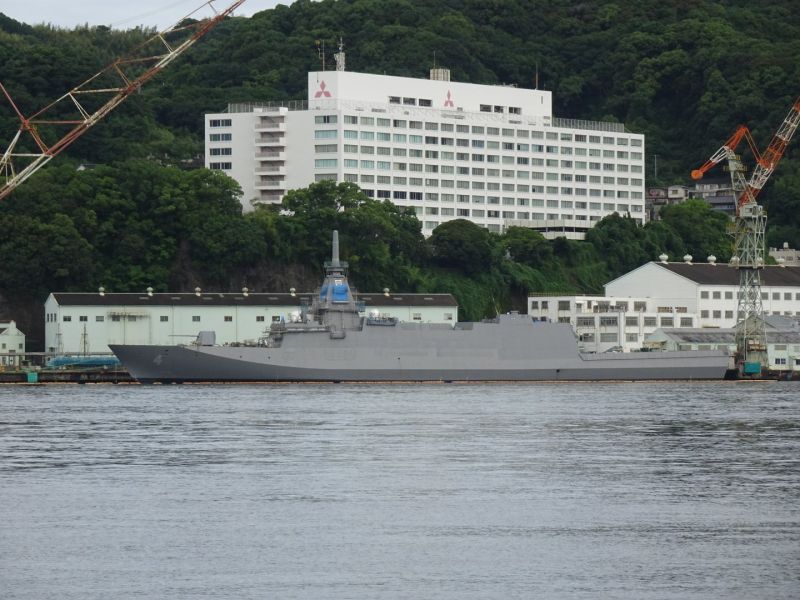

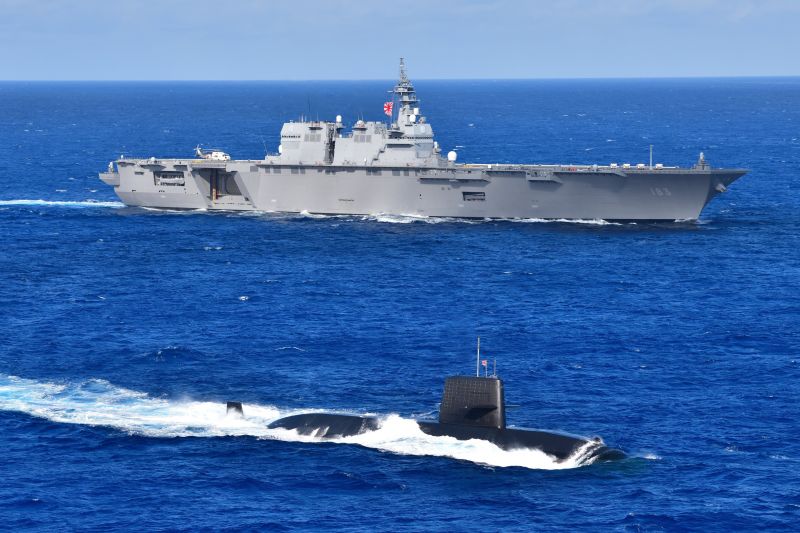
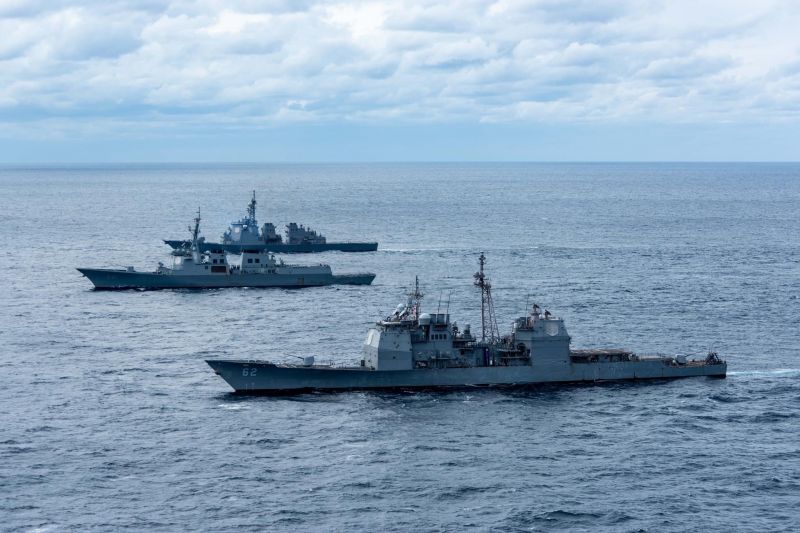


 apple17
apple17


 apple17
apple17


